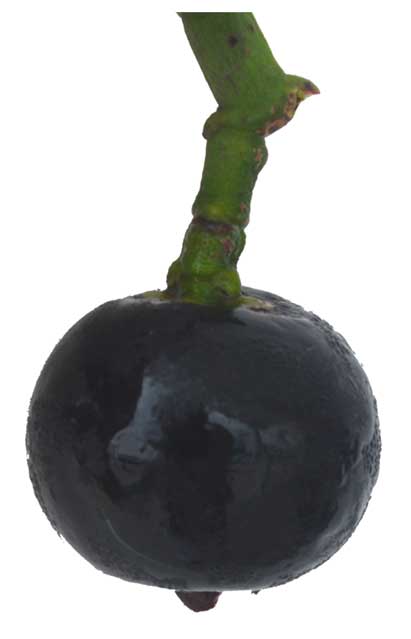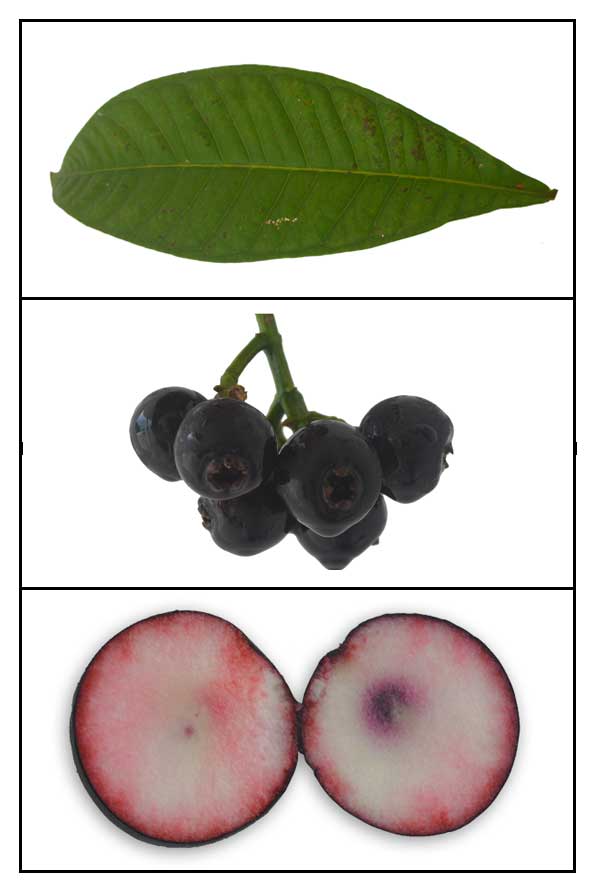 
Gen info
- Syzygium is a genus of flowering plants in the myrtle family, Myrtaceae. The genus comprises about 1200 species, the native range extending from Africa and Madagascar through southern Asia east through the Pacific.
Botany
Lipote is a small to medium-sized tree growing up to 14 meters tall. Trunk is up to 75 centimeters in diameter. Outer bark is purplish gray. Twigs are angularly winged. Leaves are alternate, oblong-lanceolate or obovate, acuminate, 6 to 20 centimeters long, 4 to 7 centimeters wide, with 14 to 16 pairs of secondary veins. Flowers are white, numerous, and in panicles. Fruits are subglobose, fleshy, red to dark purple, sweet sour, and edible, 1 centimeter in diameter.
Syzygium polycephaloides is a small to medium-sized tree up to 25 m tall, bole up to 75(-90) cm in diameter, bark surface purplish-grey. Leaves elliptical, oblong to oblanceolate, 6-20 cm × 4-7.5 cm, with 14-18 pairs of distinct secondary veins, petiole up to 5 mm long or leaves subsessile. Flowers sessile in inflorescences from branches below the leaves, white, calyx c. 5 mm long, with 4 broad lobes. Fruit a subglobose berry, 1 cm in diameter, red to purple when ripe, on bare branches just below the leaves. (10)
Distribution
- Native to the Philippines.
-
In primary forests at low and medium altitudes.
- Occasionally cultivated for its edible fruit.
- Considered vulnerable and potentially endangered.
- Also native to Lesser Sunda Is., Sulawesi.
Constituents
- Fruits are rich in vitamin C.
- On screening for flavonols and flavanols, methanol extract yielded 58.85 µg catechin g-1 fresh sample. (see study below) (7)
- Ripe fruit per 100 g contains 83% edible potion, with 83.4 g water, 77 kcal energy, 0.7 g protein, 2.5 g fat, 12.9 g carbohydrate, 1.7 g crude fiber, 93 mg calcium, 22 mg phosphorus, 0.2 mg iron, 50 µg ß-carotene, 10 µg total vitamin A, 0.01 mg thiamine, 0.02 mg riboflavin, 0.3 mg niacin, and 16 mg ascorbic acid. (8)
- Study of fruits for total flavonoids and total phenolic contents yielded
2780 µg Gallic Acid Equivalent (GAE)/g fresh sample and 5141 µg Quercetin Equivalent (QE)/g fresh sample, respectively. (9)
- Phytochemical study of ethanolic extract of leaves yielded alkaloids +++. anthraquinones ++. flavonoids +++. glycosides ++, saponins ++. steroids +, tannins +++, and terpenoids ++.
(13)
Properties
Considered antioxidant, antihypertensive.
- Studies suggest antioxidant, anti-inflammatory, antibacterial and anti-tumor properties.
 Uses Uses
Edibility
- Fruits eaten, raw or cooked.
-
Fruit used in making preserves, jellies, wine, pickles and beverages.
Folkloric
- Used for diabetes, hypertension, and high cholesterol.
- Ifugaos use the sour fruit for treating coughs. Leaf decoction used for hypertension. (6)
Others
- Wine: Source of tropical fruit wine.
- Wood: Used for construction.
Studies
• Syzygiol / Skin Tumor Inhibitory Activity: Study isolated syzygiol from Syzygium polycephaloides. It showed significant inhibitory activity of skin tumor promotion. (2)
• Antibacterial / Anti-Inflammatory / Bark: Study of alcoholic extract of lipote bark yielded active constituents, inorganic salts, carbohydrates, and proteins. The extract showed antibacterial activity, specifically Staphylococcus aureus. The bark extract also showed slight anti-inflammatory activity at dose of 1,000 mg/kg showing 19.67% protection against edema formation in female rats. (3)
• Antioxidant / Flavonols: Lipote fruit showed 77.7% inhibition of linoleic acid peroxidation. On screening for flavonols and flavanols, methanol extract yielded 58.85 µg catechin g-1 fresh sample. (7)
• Acute Oral Toxicity / Fruit: An acute oral toxicity test was conducted using OECD 425 guidelines to evaluated the toxic effects of freeze-dried lipote fruit extract (LFE) in male and female ICR mice at doses of 55, 175, 550, 2000, and 5000 mg/kbw. After 14 days, no physical, behavioral changes, neurologic, cardiorespiratory signs of toxicity or mortality were recorded. Creatinine and blood urea nitrogen (BUN) remained within normal range. Results suggest the LFE is relatively non-toxic, with an LD50 above 5000 mg/kg. (12)
• Effect of Maturity and Processing on Antioxidant Properties of Flesh and Seeds: Study evaluated the effect of maturity stage (unripe, half-ripe, and fully ripe) and processing (blanching at 90°C for 2 min and steaming at 105° for 5 min) on antioxidant content, TPC, and total anthocyanin content (TAC) and antioxidant activity by DPPH, ABTS, and FRAP assays. Results showed maturity and processing significantly affected antioxidant contents and activities of fresh lipote flesh and seeds. Blanched lipote flesh had higher TPC, TFC, and antioxidant activities than unprocessed and steamed counterparts. Seeds, especially unripe ones, have appreciable antioxidant contents and antioxidant capacity, greater than lipote flesh. Study recommended blanching as preferred processing step to increase antioxidant content of lipote flesh. Seeds should be investigated for nutraceutical applications due to high antioxidant properties. (14)
• Hypoglycemic: Study evaluated the hypoglycemic property of Syzygium polycephaloides in alloxan-induced mice. Extracts at doses of 250 and 500 mg/kg and metformin were able to considerably reduce blood glucose level (p<0.05). Histopathologically, reduced islet cells were restored to near-normal state in alloxan-induced mice. Study for secondary metabolites of leaf extract yielded alkaloids, flavonoids, triterpenes, tannins, phenols, and anthraquinones. (15)
• Syzygiol / Skin-Tumor Promotion Inhibitor: Study isolated syzygiol from the myrtaceous plant Syzygium polycephaloides. The compound exists in solution as a mixture of many tautomers and shows significant inhibitory activity of skin tumor promotion. (16)
Availability
- Wild-crafted.
- Cultivated.
|

![]()





 Uses
Uses